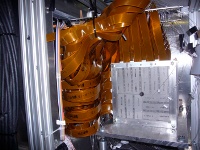 |
 |
|||||||||||||
|
|||||||||||||
|
|||||||||||||
|
This is the second report on the two detector meetings held in Korea in February, ILD and CALICE, this time focusing on the CALICE (Calorimeter for the linear collider experiment) collaboration spring meeting at Kyungpook National University in Daegu on 19 and 20 February. CALICE, launched in 2002, meets twice a year to discuss the R&D issues of calorimetry technologies and the large-scale test beam experiments, specifically in the recent meetings to prepare for the world’s first test on a digital hadron calorimeter. CALICE, attended by 50 physicists from eleven nations around the world, saw test results from the silicon and the scintillator-based version of the electromagnetic calorimeter (ECal), as well as the scintillator and digital hadron calorimeter (HCal), the two constituents for the future linear collider calorimetry. The silicon- or scintillator-tungsten electromagnetic calorimeter consists of tungsten absorbers and silicon or scintillator as active detectors. The surface area of the entire ECal amounts to 2,500 square metres, which are covered by silicon or scintillator detectors. At the meeting the performance of a silicon-based ECal was presented, where 30 layers of silicon segments with a total area of around one square metre were tested. The smallest detection unit is currently set to 1 cm by 1 cm for the silicon-based ECal, while for scintillator strips the unit is 1 cm by 4.5 cm. The silicon groups are now examining a calorimeter with 5 mm by 5 mm cell size, which has also motivated the scintillator groups to lower the unit to 5 mm by 4 cm. “Silicon detectors would be able to attain better spatial resolutions because they can be segmented as finely as desired. The current technology allows even a 0.05-millimetre digital readout detector unit called MAPS,” says Tohru Takeshita of Shinshu University, one of the organisers of the CALICE meeting. “In reality, we may need to make a compromise somewhere and seek a cost-effective alternative.” The hadron calorimeter that surrounds the electromagnetic calorimeter has a larger volume. An analogue version with 3 cm by 3 cm scintillator detectors has already been successfully tested. However, simulations of the digital hadron calorimeter have shown that a digital readout detector with 1 cm by 1 cm cells is also able to deliver the required performance. Some European groups are now pursuing a hybrid of the two, namely a semi-digital hadron calorimeter with gaseous active elements. The two-bit digital readout of this design, instead of single-bit, will allow applying multiple threshold values per channel. The CALICE meeting also laid out plans for the 2009 test beams at Fermilab. “CALICE will integrate a gaseous hadron calorimeter into their test beam set-ups and in parallel commission the second-generation ECal and HCal prototypes with integrated electronics,” explains Felix Sefkow, CALICE spokesman. The CALICE collaboration will also explore the particle flow algorithm (PFA) approach extensively to further the optimisation of the linear collider detector design. -- Misato Hayashida |
|||||||||||||
| © International Linear Collider |
